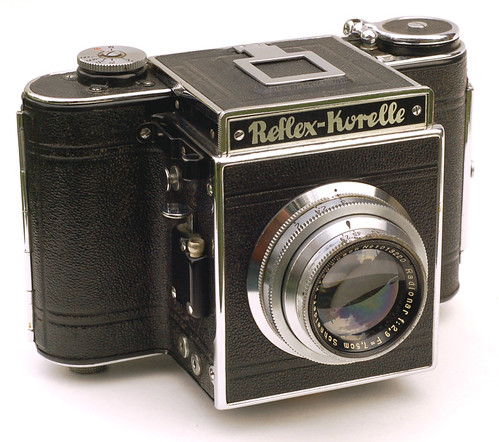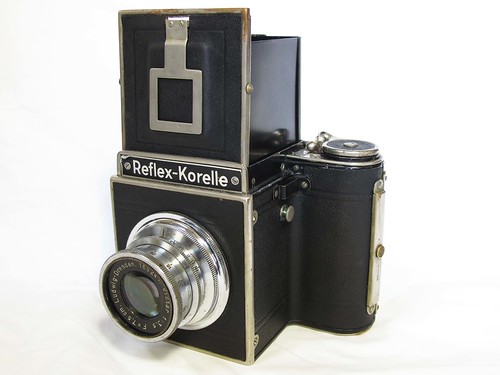Difference between revisions of "Reflex-Korelle"
Hanskerensky (talk | contribs) m (→Links: Redirected Link URL to archived version) |
(Replaced repeated refs with reused named refs; incorporated full biblio in those, so deleted bibliography section) |
||
| Line 38: | Line 38: | ||
== Evolution == | == Evolution == | ||
| − | The original '''Reflex-Korelle''' was introduced in 1935. Very early cameras were made with B, 1/10 – 1/1000 speeds, but this was quickly changed to B, 1/25 – 1/500.<REF> {{ | + | The original '''Reflex-Korelle''' was introduced in 1935. Very early cameras were made with B, 1/10 – 1/1000 speeds, but this was quickly changed to B, 1/25 – 1/500.<REF name=McK>{{McKeown12}}, pp.471-2 and 983.</ref> This revised version is called the "IA" by Matanle.<REF name=Mat> {{Matanle SLR}} pp.215–6.</REF> The lens mount is a simple screw thread with 40.5mm diameter.<ref name=Mat/> |
| − | The '''Reflex-Korelle II''', launched in 1936, has the addition of slow speed dial providing 1/20 to 2sec. and a self-timer.<REF> | + | The '''Reflex-Korelle II''', launched in 1936, has the addition of slow speed dial providing 1/20 to 2sec. and a self-timer.<REF name=McK/> Matanle calls this model the "IIA".<REF name=Mat/> After the introduction of model II, the original model without slow speeds was renamed '''Reflex-Korelle I'''.<REF name=McK/> |
| − | Some sources say that the two models were modified in 1937 with auto-stop film advance, and renamed '''Ia''' and '''IIa'''.<REF | + | Some sources say that the two models were modified in 1937 with auto-stop film advance, and renamed '''Ia''' and '''IIa'''.<REF name=McK/> A simplified '''Reflex-Korelle B''' was sold at the same period, with separate shutter winding and film advance, and with no eye-level finder.<REF name=McK/><REF name=Mat/> |
| − | A new edition of the '''Reflex-Korelle II''' appeared in 1939 with a chrome finished top plate, replacing the IIa.<REF | + | A new edition of the '''Reflex-Korelle II''' appeared in 1939 with a chrome finished top plate, replacing the IIa.<REF name=McK/> The '''Reflex-Korelle III''', released the same year, has chrome plating on the front plate and viewing hood, redesigned controls and speeds from 2s to 1/1000. It introduced a large-diameter bayonet mount, which was also fitted on some examples of the model II.<REF name=McK/> Korelle-Werk G.H. Brandtmann continued development of the camera during the War, and announced plans for a model (the '''Elektro-Korelle''' according to McKeown) incorporating an internal coupled light meter.<ref>[https://worldwide.espacenet.com/patent/search?q=pn%3DFR890808A French Patent 890808A] of 1944, by Korelle-Werk G.H. Brandtmann of Germany, for a reflex camera incorporating a lightmeter, at [http://worldwide.espacenet.com/ Espacenet], the patent search facility of the European Patent Office.</ref> This camera was never produced. |
| − | After World War II, production of the camera was resumed in 1947 by Korelle-Werk, nationalized as [[WEFO|VEB WEFO]] in 1948.<REF> [https://web.archive.org/web/20080112212729/http://www.retrography.com/kochmann.htm Reflex-Korelle] (archived) at retrography.com. </REF> The [[Meister-Korelle]] is a redesigned model, sold in the USA as the '''Master Reflex'''. It has yet another lens mount, with a large diameter screw thread. WEFO was merged into [[Welta]] in 1951, and the production of the camera lasted until 1952.<REF | + | After World War II, production of the camera was resumed in 1947 by Korelle-Werk, nationalized as [[WEFO|VEB WEFO]] in 1948.<REF> [https://web.archive.org/web/20080112212729/http://www.retrography.com/kochmann.htm Reflex-Korelle] (archived) at retrography.com. </REF> The [[Meister-Korelle]] is a redesigned model, sold in the USA as the '''Master Reflex'''. It has yet another lens mount, with a large diameter screw thread. WEFO was merged into [[Welta]] in 1951, and the production of the camera lasted until 1952.<REF name=McK/> |
== Available lenses == | == Available lenses == | ||
| Line 99: | Line 99: | ||
== Notes == | == Notes == | ||
<references /> | <references /> | ||
| − | |||
| − | |||
| − | |||
| − | |||
== Links == | == Links == | ||
Revision as of 23:40, 3 September 2020
| ||
| ||
|
The Reflex-Korelle is a reflex camera made by Franz Kochmann, later Korelle-Werk, Dresden. It is one of the earliest 6×6cm SLRs (it was preceded by the Eichapfel Noviflex by a few months). There were a number of models, with improvements in the design. The Meister-Korelle by VEB WEFO is a postwar development of the Reflex-Korelle, also sold as the Master Reflex.
Copies of the Reflex-Korelle were made in various countries, for example the British Agiflex or the Japanese Reflex Beauty.
Contents
General description
The camera takes 6×6cm exposures on 120 film. It has a focal plane shutter with horizontally running cloth curtains. There is a fixed waist-level viewfinder on top, with a matte screen and a magnifier. The viewing hood has an additional folding frame finder at the top. The camera is focused by turning the lens helicoid. It has a fine thread 41mm lens mount.
Evolution
The original Reflex-Korelle was introduced in 1935. Very early cameras were made with B, 1/10 – 1/1000 speeds, but this was quickly changed to B, 1/25 – 1/500.[1] This revised version is called the "IA" by Matanle.[2] The lens mount is a simple screw thread with 40.5mm diameter.[2]
The Reflex-Korelle II, launched in 1936, has the addition of slow speed dial providing 1/20 to 2sec. and a self-timer.[1] Matanle calls this model the "IIA".[2] After the introduction of model II, the original model without slow speeds was renamed Reflex-Korelle I.[1]
Some sources say that the two models were modified in 1937 with auto-stop film advance, and renamed Ia and IIa.[1] A simplified Reflex-Korelle B was sold at the same period, with separate shutter winding and film advance, and with no eye-level finder.[1][2]
A new edition of the Reflex-Korelle II appeared in 1939 with a chrome finished top plate, replacing the IIa.[1] The Reflex-Korelle III, released the same year, has chrome plating on the front plate and viewing hood, redesigned controls and speeds from 2s to 1/1000. It introduced a large-diameter bayonet mount, which was also fitted on some examples of the model II.[1] Korelle-Werk G.H. Brandtmann continued development of the camera during the War, and announced plans for a model (the Elektro-Korelle according to McKeown) incorporating an internal coupled light meter.[3] This camera was never produced.
After World War II, production of the camera was resumed in 1947 by Korelle-Werk, nationalized as VEB WEFO in 1948.[4] The Meister-Korelle is a redesigned model, sold in the USA as the Master Reflex. It has yet another lens mount, with a large diameter screw thread. WEFO was merged into Welta in 1951, and the production of the camera lasted until 1952.[1]
Available lenses
Small thread mount
Incomplete list:
- Carl Zeiss Tessar 7.5cm f/2.8
- Carl Zeiss Tessar 7.5cm f/3.5 (earlier model)
- Carl Zeiss Tessar 8cm f/2.8
- Carl Zeiss Tessar 8cm f/3.5
- Carl Zeiss Tessar 10.5cm f/4.5
- Carl Zeiss Tessar 13.5cm f/4.5
- Carl Zeiss Tele Tessar 18cm f/6.3
- Cooke Telephoto 15cm (6") f/5.6
- Dallmeyer Dallon Tele-Anastigmat 15cm (6") f/5.6
- Dallmeyer Adon 23cm f/4.5
- Ludwig Victar 7.5cm f/2.9
- Ludwig Victar 7.5cm f/3.5
- Meyer Primoplan 8cm f/1.9
- Meyer Tele Megor 40cm f/5.5
- Schneider Xenar 7.5cm f/2.8
- Schneider Xenar 7.5cm f/3.5
- Schneider Radionar 7.5cm f/2.9
- Schneider Radionar 7.5cm f/3.5
- Schneider Xenar 10.5cm f/4.5
- Schneider Xenar 13.5cm f/4.5
- Schneider Tele-Xenar 24cm f/4.5
- Schneider Tele-Xenar 30cm f/5.5
- Schneider Tele-Xenar 36cm f/5.5
- Steinheil Cassar 8cm f/3.5
Bayonet mount
For the Reflex-Korelle III.
Incomplete list:
- Carl Zeiss Tele-Tessar 25cm f/6.3
- Schneider Xenar 7.5cm f/2.8
- Schneider Xenar 13.5cm f/4.5
- Schneider Tele-Xenar 18cm f/5.5
- Schneider Tele-Xenar 30cm f/5.5
Large 55mm thread mount
For the Meister-Korelle and Master Reflex:
- Carl Zeiss Tessar 80mm f/2.8
- Meyer Primotar 85mm f/3.5
- Carl Zeiss Tessar 105mm f/3.5
- Meyer Makro-Plasmat 105mm f/2.7
- Carl Zeiss Tessar 135mm f/4.5
- Carl Zeiss Tessar 165mm f/3.5
- Meyer Primotar 180mm f/3.5
- Meyer Tele-Megor 250mm f/5.5
Notes
- ↑ 1.0 1.1 1.2 1.3 1.4 1.5 1.6 1.7 McKeown, James M. and Joan C. McKeown's Price Guide to Antique and Classic Cameras, 12th Edition, 2005-2006. USA, Centennial Photo Service, 2004. ISBN 0-931838-40-1 (hardcover). ISBN 0-931838-41-X (softcover)., pp.471-2 and 983.
- ↑ 2.0 2.1 2.2 2.3 Matanle, Ivor. Collecting and Using Classic SLRs. London: Thames & Hudson, 1996. ISBN 0-500-01726-3. pp.215–6.
- ↑ French Patent 890808A of 1944, by Korelle-Werk G.H. Brandtmann of Germany, for a reflex camera incorporating a lightmeter, at Espacenet, the patent search facility of the European Patent Office.
- ↑ Reflex-Korelle (archived) at retrography.com.
Links
In English:
- Reflex-Korelle at Cosmonet's Classic Camera (archived)
- Reflex-Korelle at medfmt (archived)
- Korelle instruction manual at Butkus.org
- Reflex-Korelle listed at number 19 in Jason Schneider's Top 20 Cameras Of All-Time on Shutterbug.
In French:


